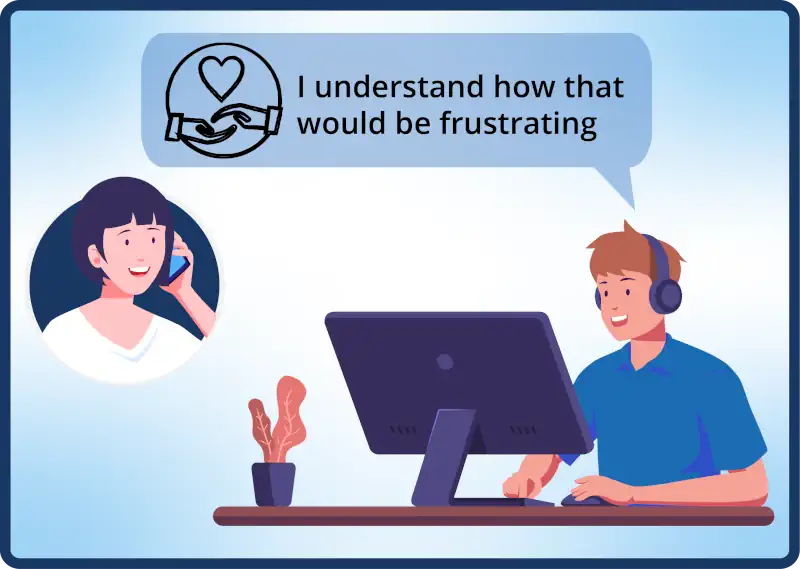Managing difficult customers over the phone presents unique challenges. For agents, knowing how to handle difficult customers requires a balance of emotional intelligence and effective communication. Without visual cues, they must rely on tone, pacing, and word choice to build trust and guide the interaction.
When contact center agents are equipped with the right strategies for dealing with difficult customers, they are more confident, efficient, and capable of guiding even the most challenging conversations toward resolution. This also helps strengthen First Call Resolution (FCR), customer loyalty, and overall satisfaction.
In this blog, we’ll discuss actionable techniques, including customer service de-escalation techniques, and best practices for handling difficult customers. These tools support both agent confidence and positive customer outcomes.
What are Strategies for Handling Difficult Customers Over the Phone?
When it comes to handling difficult conversations, preparation and a calm, solution-focused mindset are essential. While these conversations may feel intimidating, having a clear strategy in place can help agents manage them effectively and confidently.
These key strategies are each designed to support agents in navigating tough interactions with confidence and professionalism.
1. Stay Calm and Composed
Remaining calm during emotionally charged interactions is critical. Customers can sense the frustration in your voice, which may escalate their own emotions. Practicing composure sets a steady tone and keeps the conversation constructive.
Train agents to take a breath before responding and remain neutral in tone. Responding with calmness builds trust and reinforces the idea that you're there to help, not to argue.
Maintaining self-control helps ensure the focus remains on resolving the customer’s issue—an essential step toward first call resolution and delivering a positive experience.

2. Practice Active Listening
Active listening is more than just hearing words—it's about understanding the customer’s emotions and concerns. Agents should listen without interrupting and use verbal nods to show they’re engaged and attentive.
Rephrasing the issue back to the customer confirms clarity and demonstrates attention to detail. This encourages collaboration instead of confrontation, which is key to handling difficult customers effectively.
Listening without judgment also helps customers feel respected, even when they’re upset. Managing difficult customers starts with understanding the root of their frustration.
3. Communicate with Empathy
Empathy in customer service is key to humanizing the interaction. Acknowledging the customer’s frustration shows you care about their experience—even if the issue isn’t directly your fault.
Phrases like “I understand how that would be frustrating” validate the customer’s emotions. This validation can quickly de-escalate tension and shift the conversation in a more productive direction.
Agents who lead with empathy can often turn a negative call into a relationship-building moment. Contact center de-escalation techniques rooted in empathy can help retain even the most upset customers.

4. Take Responsibility and Offer Solutions
Even if the problem wasn’t caused by the agent, taking ownership of the solution demonstrates accountability. Customers appreciate it when agents commit to resolving the issue without deflection.
Avoid blaming other departments or making excuses. Focus instead on what you can do at the moment to move toward a resolution.
This kind of ownership not only builds trust but also improved first call resolution by reducing the back-and-forth that frustrates customers.
5. Use De-Escalation Techniques
Customer service de-escalation techniques are critical when dealing with difficult customers. Training agents to identify emotional triggers early helps prevent escalation.
Techniques like mirroring the customer’s concern, slowing down speech, and asking clarifying questions can calm the situation. Empathy paired with action demonstrates that the issue is taken seriously.
Incorporating de-escalation techniques into daily workflows supports a smoother customer experience and reduces the likelihood of repeat contacts or escalated complaints.

6. Tailor Resolutions to the Customer
Customers want practical resolutions that feel tailored to their situation. Agents should take the time to understand what the customer needs and respond with clarity.
Whether it’s issuing credit, scheduling a follow-up, or clarifying next steps, ensure that the solution is communicated simply and effectively. When dealing with difficult customers, agents should always include steps for clarity and follow-through.
Making sure the customer understands the plan reinforces confidence and avoids confusion. Tailored resolutions also boost customer satisfaction and reduce negative word-of-mouth.
7. Leverage Support Systems
Not all issues can be resolved independently. Knowing when to escalate ensures customers get the right support while avoiding unnecessary delays.
When transferring calls, agents should clearly explain why and ensure a smooth handoff. The original agent should remain engaged until the issue is reassigned.
Using internal resources strategically supports contact center conflict resolution and allows for faster issue resolution, ultimately enhancing the customer experience.

8. Follow Through and Close the Loop
Following up is essential to building trust. When agents say they’ll call back or send an email, they must follow through as promised.
Even a small failure in follow-up can undo an otherwise successful resolution. Consistency builds credibility and shows customers that they’re valued.
Never promise more than what can realistically be delivered.
Closing the loop after a difficult interaction reinforces care and accountability. This is a best practice for handling difficult customers that builds loyalty over time.
9. Train Agents to Handle Difficult Customers
Ongoing training is key to difficult customer management. Training sessions should include role-playing, customer service de-escalation scenarios, and contact center customer experience tips.
When agents practice how to deal with angry customers before facing them on the phone, they’re more likely to succeed under pressure. Training should also include updates to call center difficult scripts as trends evolve.
A culture of continuous learning helps reduce agent stress and improves team performance. This investment in skill-building ultimately benefits both agents and customers.

10. Create a Culture of Empathy and Accountability
Managing difficult customers isn’t just about frontline tactics—it’s a cultural commitment. Leaders must model empathy and empower agents to take ownership of customer outcomes.
Clear escalation paths, performance coaching, and praise for well-handled tough calls reinforce a customer-first mindset. Difficult customer scripts and tips should be accessible and regularly updated.
When the entire organization supports difficult customer interactions with the right mindset and tools, it enhances every touchpoint in the customer journey.
Turn Customer Tension Into Trust
Every contact center interaction is a chance to either strengthen or weaken the customer relationship. Poorly handled calls can lead to:
 Decreased FCR
Decreased FCR
 Lower CSAT scores
Lower CSAT scores
 Negative word-of-mouth, or online reviews
Negative word-of-mouth, or online reviews
On the other hand, managing complaints with professionalism and empathy often improves brand perception. In fact, a customer who has their issue resolved effectively is more likely to remain loyal than one who never had a problem in the first place.
Mastering how to handle difficult customers is not just a skill for agents, it’s a strategy for long-term business success.
By creating a culture of empathy, ownership, and continuous improvement, contact centers can turn challenging customer interactions into opportunities to enhance satisfaction and loyalty.
